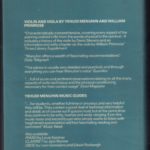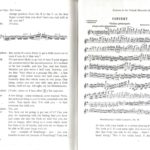Price and stock to confirm
Ed. MacDonald and Jane’s, 1978. Hard cover with Dust Jacket. Size 22,5 x 14,5 cm. With 21 photographs black and white. State: Used, excellent. 250 pages
The violin, delicate and small as it is, holds too much of the history of man, his creative gifts, his craftsmanship, his emotion and thought, to be encompassed by any one writer. A performer brings the violin to life and makes it sing, and this may be the ultimate function of the violin as the bridge between the one and the many. But he does not necessarily know all about its history, its constituent parts and the supremely skilled workmanship that goes into the making of a great instrument.
I am, therefore, all the more happy and grateful to those who have fulfilled the inherent scope of the subject.
To Denis Stevens for his sense of patient scholarship and for his insight into the origins and development of the instrument we know as the violin today. To Etienne Vatelot, that most eminent craftsman, who has spoken so pertinently about the composition of the violin. And very particularly to Bill Primrose; even though I have ventured into the viola literature and adore playing the instrument, I could not presume to write about it with the authority of a man who has given it his whole life, nor could I have written with the wit and originality that mark his chapter.
The violin is made up of 82 or 84 pieces of wood, over and above wich the belly or the back is made up of one or two pieces.
The woods used are maple for the back, the ribs and the scroll, pine for the belly, ebony for the fingerboard, and boxwood, rosewood or ebony for the pegs, tail-piece and tail-pin.
The success of the instrument’s resonance depends on several factors: on the choice and age of the wood, on the design of the contours, on the curve of the table and of the back, on the thicknesses, on the tension of the bass-bar supporting the belly, on the fluidity of the varnish, on the adjustement of the tension and the position of the sound-post (a small cylinder of deal wedged between the belly and the back) which needs only to be a tenth of a millimetre out of place to alter the sound, on the cut of the bridge, on the angle made by the strings and their place on the bridge, and on the diameter of the strings.
 To all these factors are added the taste and even the character of the violinist, who looks to his instrument not only for power and resonance but also for a reflection of his own personality.
To all these factors are added the taste and even the character of the violinist, who looks to his instrument not only for power and resonance but also for a reflection of his own personality.
The violin maker therefore must not only pay attention to the physical condition of the violin, which varies according to climate, and consequently hygrometry, but also keep the instrument in a state of receptivity for the actual violinist who will have the responsibility and the talent to play it.
 As for the bow, made from a Brazilian wood, it must be both strong and supple, both light and balanced. The horsehair is attached at one end to the head and at the other to the frog of the bow. it is held by a tail-pin attached by a screw hook. The strands of this horsehair must be both strong and elastic and usually come from Canada or Siberia.
As for the bow, made from a Brazilian wood, it must be both strong and supple, both light and balanced. The horsehair is attached at one end to the head and at the other to the frog of the bow. it is held by a tail-pin attached by a screw hook. The strands of this horsehair must be both strong and elastic and usually come from Canada or Siberia.
Depending on the quality of the bowstick, the bowmaker can decorate the frog with such precious materials as ivory, tortoiseshell and gold. But however beautiful a bow may appear, only the violinist can judge its worth.
CONTENTS
Yehudi Menuhin’s Preface
The Instrument, by Etienne Vatelot
PART ONE: THE VIOLIN, by Yehudi Menuhin
1- The Violin and the Violinist
A platonic relationship – the Violinist and his Violin
Space and sensation – the Violinist and hi Body
2- The Preparation of the Violinist
Physical preparation:
-exercises
-relaxation
-diet
How body exercises work
Breathing exercises
Mental and spiritual preparation
3- First Facts
A coordination of balance and movement:
-the body as a whole
-wrist and fingers
-thumb
-shoulder
The hold: the left hand
The hold: the right hand
Fingers on the bow
Cultivating sensation
Body stance and bowing
Warming cup
4- Technique
Some aims to follow
Some common faults
Oscillating exercises
Whole body swing
Exercises with violin and bow
The left hand
Left hand exercises:
-finger exercises
-shifting
-vibrato
-trills
Further left hand development
Double stops
Chords
When practising
Right hand finger exercises
The up-bow
A very useful approach to develop lightness and balance in the right hand:
-co-ordination with the left hand
Different levels of left and right arms
-follow-through exercises
-bowing exercises
Three basic strokes in violin playing:
-short martelé
-short détaché
-smooth strokes
Bowing pressures
String crossings and bounce exercises
The range of violin bowing
Some specific strokes:
-martelé
-staccato
-portato
-vibrato
Developing a good bow arm
Retakes
Ricochet
Spiccato
5- Practising
Discipline
Developing stamina
The need for relaxation
Using a mute
Variety in practice
-practising on a viola
Thought and analysis
6- The Violinist in Action
The leader
The leader of the second violins
The orchestral player
The chamber musician
On being a soloist
The recitalist with piano
The contemporary world
Critics
7- Repertoire and Interpretation
Analysis
«Distortion and correction»
Memory
Improvisation
The versatility of the violin
Bach
Paganini
In detail: Bach’s D minor Partita and Beethoven’s Violin Concerto
8- The Making, repair and Care of the Violin and Bow
Some famous violin-makers and their instruments
The bow
The repair of the Violin
The care of the Violin
-tuning
9- Teaching
10- Lessons at the Yehudi Menuhin School
PART TWO: THE VIOLA, by William Primrose
11- The Viola
An instrument in its own right
Bowing
Fingering
Holding and positioning
Size
Repertoire
Teaching and Vibrato
Coda
PART THREE A SHORT HISTORY, by Denis Stevens
12- Early History
Introduction
Terminology
Repertoire: manuscript music
Repertoire: printed music
Instruction books
13- Bach’s Sonatas and Partitas for Violin
BRIEF GLOSSARY
SOME SELECTED FURTHER READING
DISCOGRAPHY


